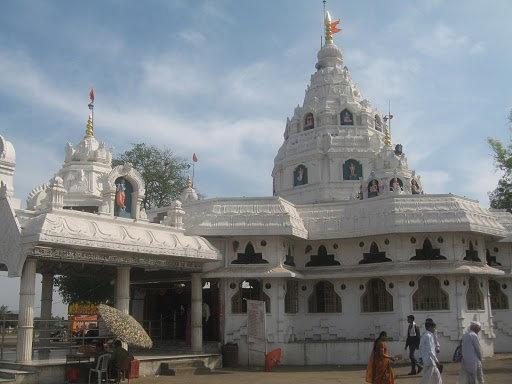Aurangabad
Popular Tourist Places

Ajanta Caves
This private tour will take you to visit Ajanta's wondrous cave temples, a World Heritage site, that cut the rocks into a dramatic crescent-shaped gorge. On the top the gorge, there is a beautiful waterfall that drops over the mountain rim in a series of seven steps to a pool below. It is dated back to the 2nd century B.C. covering a span of 800 years and during the period professional artists helped Buddhist monks to create magnificent murals narrating the story of Buddha in his cycle of incarnations. The caves are etched and painted with vegetable and mineral dyes and the paintings have languorous beauty and magical eloquence.

Ellora Caves
You will see the famous rock cut caves temples of Ellora that were constructed between the 5th and 8th centuries A.D depicting the Hindu, Buddhist and Jain faiths. You will particularly enjoy the architectural marvel of the monolithic Kailasa Temple that is carved out from the rocky cliff-side from top to bottom.

Grishneshwar Jyotirlinga Temple
The Grishneshwar Jyotirlinga Temple is one of the ancient and holiest shrines of India. This temple is the holy abode of one of the 12 jyotirlinga of Lord Shiva. The temple is located at a distance of 11km from Daulatabad near Aurangabad in Maharashtra. Daulatabad was once known as Devagiri. Ahilyabhai Holkar constructed the Grishneshwar Temple, who also re-constructed the Kasi Viswanatha temple at Banaras and the Vishnu Paada temple at Gaya.. About 30 km towards the west side of Aurangabad.

Bibi Ka Maqbara
Bibi Ka Maqbara is situated 5 km away from Aurangabad. Aurangazeb's son, Prince Azam Shah built it in 1678 in the memory of his mother Begum Rabia Durani. This mausoleum is a replica of the famous Taj Mahal. Bibi Ka Maqbara has four towering minarets like Taj Mahal. An octagonal lattice-screen of white marble surrounds the raised plinth supporting Rabia Daurani's grave inside the tomb. The tips of its pillars are made of red stone. The monument becomes so beauty when its reflection falls on the water as soon as the sun's first rays fall on it.

Aurangabad Caves
The Aurangabad caves are twelve rock-cut Buddhist shrines located on a hill running roughly east to west, close to the city of Aurangabad, Maharashtra. The first reference to the Aurangabad Caves is in the great chaitya of Kanheri Caves. The Aurangabad Caves were dug out of comparatively soft basalt rock during the 6th and 7th century. The caves are divided into three separate groups depending on their location. The cave temples of Aurangabad cut between the 6th and the 8th century are nine kilometers from Aurangabad city center, a few kilometers from the campus of Dr Babasaheb Ambedkar Marathwada University and the Bibi-ka-Maqbara.

Bhadra Maruti Temple, Khuldabad
Bhadra Maruti Temple, Khuldabad is a temple dedicated to the Hindu deity Hanuman, located at Khuldabad, near Aurangabad, Maharashtra. The temple is located four kilometers from the Ellora caves The Bhadra Maruti Temple is considered one of the tourist attractions near Aurangabad and people gather in lakhs during auspicious occasions like Hanuman Jayanti and Ram Navami. People from Aurangabad and nearby places walk to the temple to offer puja on Saturdays in the Marathi calendar month of "Shravan"

Siddharth Garden
Siddharth Garden is a famous park and zoo located in the city of Aurangabad, Maharashtra. It is located near the Central Bus Stand of Aurangabad. The garden is one of the popular recreational centres of the city.

Panchakki (Water Mill)
Panchakki,(Devanagari: पानचक्की) also known as the water mill, takes its name from the mill which used to grind grain for the pilgrims. This monument located in Aurangabad, Maharashtra, displays the scientific thought process put in medieval Indian architecture. It was designed to generate energy via water brought down from a spring on a mountain.

Jain Temple
The Jain temple is located at Kachner village, near Aurangabad. Placed at a distance of around 37 km from Aurangabad this place is famous for the Chintamani Parshvanath installed inside the temple. This beautiful idol was discovered at an underground basement around 250 years ago. It is believed that the idol has some miraculous powers that can solve the problems of the people who seek divine intervention of the deity.

Jayakwadi Dam
The Jayakwadi project is one of the largest irrigation projects in the Indian state of Maharashtra. It is a multipurpose project. The water is mainly used to irrigate agricultural land in the drought-prone Marathwada region of the state. It also provides water for drinking and industrial usage to nearby towns and villages and to the municipalities and industrial areas of Aurangabad and Jalna district. The surrounding area of the dam has a garden and a bird sanctuary. The foundation of the dam was laid by the then Prime minister of India Lal Bahadur Shastri on 18 October 1965. The dam was inaugurated on 24 February 1976 by the then Prime minister Indira Gandhi.
